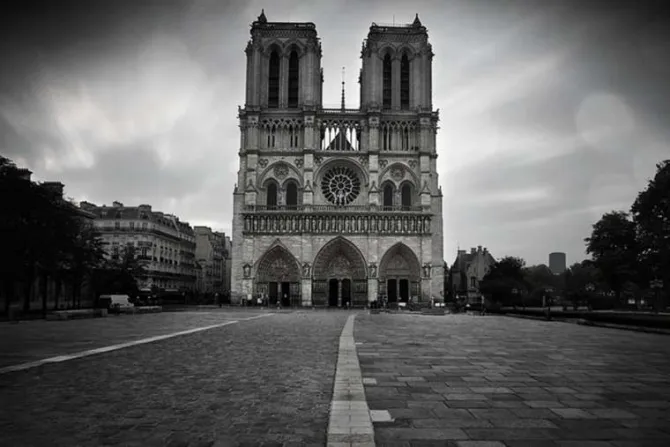Paris, France, Apr 15, 2019 / 12:34 pm
Firefighters in Paris are battling a fire in the roof of the Cathedral of Notre-Dame in Paris, which threatens to destroy one of Europe's oldest and most recognizable Catholic cathedrals. The cause of the fire remains unknown.
Construction on the Gothic-style cathedral began over 850 years ago and took nearly 200 years to fully complete.
Notre-Dame was built on the ruins of two earlier churches which were themselves built over a temple dedicated to the Roman God Jupiter. Pope Alexander III laid the foundation stone for the cathedral in 1163, and the high altar was consecrated 26 years later.
The 223 foot-high towers were built between 1210 and 1250, and the church was officially completed in 1345.
The central spire- the epicenter of the April 15 fire- was added during a 19th century renovation.
King Henry VI of England was crowned in the cathedral in 1431.
Though it suffered damage, the cathedral escaped possible destruction during the French Revolution, when Napoleon crowned himself king of France in 1804. It survived two world wars largely unscathed, the BBC reports.
Pope Pius X beatified Joan of Arc, perhaps France's most famous Catholic martyr, in Notre-Dame cathedral in 1909.
Relics in the cathedral include a crown of thorns believed to have been worn by Christ before his crucifixion and a piece of wood believed to be part of the cross on which Christ was crucified. Initial reports say these relics were spared from damage during the fire.
Among countless works of art and historical artifacts contained within the cathedral, the Notre-Dame's treasures included a "17th century organ with all of its parts still functional," the Notre-Dame's website says.
The cathedral is one of the world's most recognizable landmarks and has been immortalized in literary works such as Victor Hugo's "The Hunchback of Notre-Dame," which in French is titled "Notre-Dame de Paris."
Officials had been in the process of a massive fundraising effort to renovate the cathedral against centuries of decay, pollution, and a flow of 13 million visitors annually. French conservationists and the archdiocese announced in 2017 that the renovations needed for the building's structural integrity could cost as much as $112 million to complete.
A major campaign of cleaning and restoration was carried out from 1991–2000.
The Catholic Church in France, and the Notre-Dame specifically, have experienced various terrorist threats and attacks in the past several years, mainly from Islamic extremism.
Attacks by extremists in Paris in November 2015 killed 147. Cardinal André Vingt-Trois celebrated Mass at the cathedral the Sunday after, offered for those killed or wounded in the attacks, with more than 9,000 attendees inside and thousands more standing outside in silence.
In July 2016, Islamic extremists carried out an attack in Saint-Etienne-du-Rouvray in which a priest, 85-year-old Father Jacques Hamel, had his throat slit while celebrating Mass.
French police arrested six people in Sept. 2016 after finding an abandoned car in the vicinity of the Notre-Dame, with the emergency flashers on and inside various cooking gas cylinders, a blanket soaked in gasoline and an extinguished cigarette, but no detonation devices. Two of those arrested had ties to the so-called Islamic State militant group.
(Story continues below)
Another car packed with explosives was found a few days later near the Notre-Dame. French authorities subsequently charged a woman in connection with an alleged terrorist plot to attack the cathedral with a car bomb.
In June 2017, a man attacked police officers at Paris police headquarters next to the Notre-Dame. Police subsequently shot the suspect in the chest and took him into custody.
Reports from French news sources and watch groups in early 2019 have tracked at least 10 incidents of vandalism and desecration of Catholic churches in France since the beginning of February.


